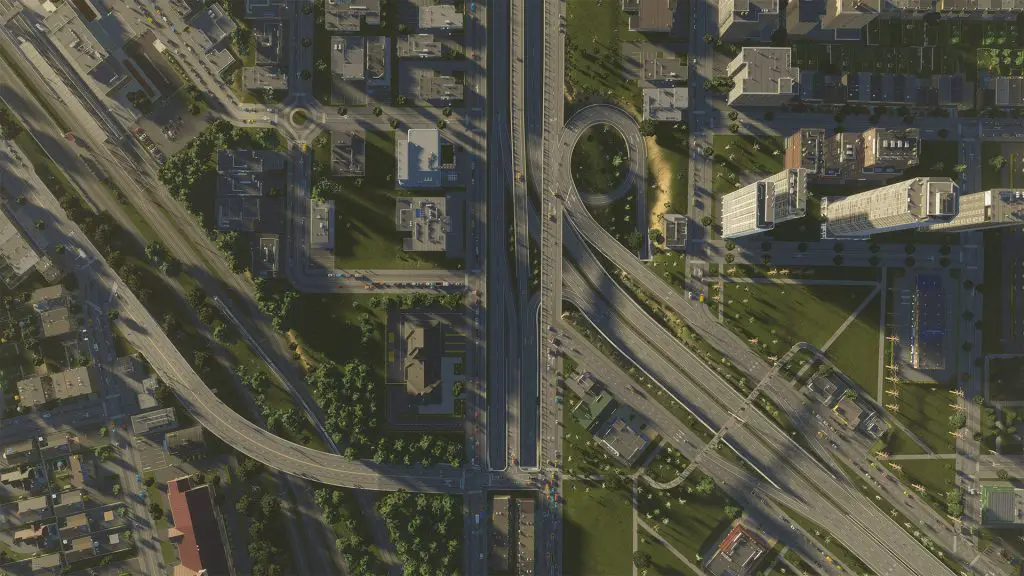The existence of Cities: Skylines is a result of a close call and a dose of serendipity. Initially, both the publisher, Paradox, and the developer, Colossal Order, who were known for the Cities in Motion series, had reservations about moving forward with the project. The fear of the resurgent SimCity franchise dominating the market almost led to the cancellation of Cities: Skylines. However, fate had a different plan. The tumultuous launch of SimCity in 2013 opened the door for a new, more vibrant challenger. Armed with valuable player feedback from the SimCity disaster, Cities: Skylines was launched in 2015 and, within its first month, swiftly sold over a million copies. Now, Cities: Skylines II has arrived, poised to bring essential updates to the series’ foundation, accompanied by a significant graphical overhaul. In keeping with the series’ tradition, the development team has kept a keen ear to the ground, heeding the desires of the players and delivering on their expectations.

Choose Perfect Starting Point in Cities: Skylines II
In Cities: Skylines II, the game offers an array of pre-made terrain maps, each with its unique characteristics. I opted for the river delta as my starting location, a choice that provided ample room for expansion and the significant advantage of easy access to water—a vital resource for any thriving city.

As a newcomer to the game, I found the provided tutorial to be remarkably comprehensive. It furnished a thorough understanding of how to construct and maintain my city without making me feel constrained. Cities: Skylines II’s progression mechanism is a testament to design brilliance. It unfolds seamlessly as your city grows, ensuring that you’re never inundated with an overwhelming array of new options, as you always get to decide what comes next.
At each level your city attains, you earn unlock points. These points serve as currency to advance along the progression tracks for various city services and to acquire expansion points for broadening your buildable territory. For experienced players, this progression system is undoubtedly the most exciting aspect, as it directly addresses the requests they’ve been making.
Infrastructural Limitations in Cities: Skylines II
The original Cities: Skylines faced infrastructural limitations that couldn’t be entirely modded out. As your city reached specific population or building limits, the game’s performance would deteriorate. However, with the sequel, the aim was to eliminate these constraints, a goal that becomes strikingly evident when you zoom out and witness the vastness of the available space.
The buildable size of the game’s maps is genuinely mind-boggling, offering endless possibilities for urban development. While this expansive canvas might appear intimidating, especially for a newcomer like me, the initial city size is quite manageable and serves as an excellent starting point for your ambitious city-building journey.
Mechanism of Cities: Skylines II
Upon returning to the tutorial in Cities: Skylines II, players are gradually introduced to the fundamental mechanics of zoning, power supply, sewage management, and other critical aspects. This gradual unveiling of mechanics enables players to establish their networks before delving into more intricate challenges and discovering how to perform tasks more efficiently. For instance, a valuable lesson I learned through experience is the benefit of opting for medium-sized roads as a default choice, except when exclusively building a residential neighborhood. This decision ensures smoother traffic flow and more effective city planning.

Skylines II stays true to its predecessor’s legacy but takes it a step further by raising the bar for the city-building games. The tutorial’s gradual pace ensures that the game’s complexity doesn’t overwhelm players. Learning how to balance the city’s diverse needs, which encompass education, healthcare, network coverage, and more, feels like a manageable and gradual process. This approach successfully eases players into the deep intricacies of Skylines II without immediately drowning them in overwhelming responsibilities.
ALSO READ: SUPER BOMBERMAN R 2 REVIEW – EXPLORING EXPLOSIVE EVOLUTION
City Management in Cities: Skylines II
As your city takes shape in Cities: Skylines II, the game’s depth of gameplay becomes increasingly evident. You’ll find yourself meticulously monitoring various metrics, such as the city’s education level and the proximity of your schools to becoming overpopulated. A growing population means more students, which in turn makes building additional districts a necessity to sustain the city’s growth.

Furthermore, managing your city’s power generation becomes essential. Juggling these demands becomes more challenging as you address various problems and cope with random disasters that can unexpectedly occur. Pop-up notifications throughout the city keep you informed of these challenges and necessitate your swift response.
However, this stage of the game is where I encountered my first roadblock: the game doesn’t seem to excel at helping players understand how to generate revenue effectively. While you do receive a cash bonus with each level-up, there comes a point where your expenses might outstrip your income. My attempts to increase tax revenue without raising taxes too rapidly proved unsuccessful, and regardless of what I tried, my finances remained in the red.
Skylines II, despite any initial financial challenges, serves as a solid foundation for potential future expansions and fan-made content. Its out-of-the-box offerings are accessible to newcomers, promising endless possibilities and countless hours of creative enjoyment.
Financial Challenges and Industrial Demand in Cities: Skylines II
To overcome the financial challenge I encountered, I resorted to constructing additional environmental power plants. By exporting excess electricity, I was finally able to restore financial stability. While this solution may seem like a brute-force approach, it proved effective in addressing the issue. Additionally, I implemented several cargo export networks and allocated space to the logging industry, logical responses to the game’s mechanics and its revenue system.
Another notable aspect of the game is its seemingly insatiable demand for industrial zones. It often felt as if no quantity of industrial buildings I zoned could ever be sufficient. The demand bar would deplete, only to fill up again, often at a faster rate than other bars. My assumption was that the increasing population required job creation. However, it was perplexing to observe that commercial buildings in the city frequently reported not having enough customers. This left me confused about the relationship between the growing population and the purportedly struggling businesses.
Despite these quirks, my city rarely encountered severe problems, and these idiosyncrasies did not hinder its overall development. While they were among the game’s more puzzling elements, they did not ultimately lead to the failure of my city, making them relatively minor concerns.
While Cities: Skylines II offers a fantastic city-building games experience, it does have some downsides. One significant issue, which is not impacting my score as the developers are actively working on it, is the game’s lack of optimization. This may have been the reason behind the recent significant delay of the console versions, as neither of the most powerful systems on the market meets the equivalent recommended specifications.
When examining the Steam page for the game, it becomes evident that Skylines II recommends a high-end graphics card or equivalent, a specification that less than ten percent of Steam users currently possess. The minimum requirements are more reasonable, but even with my PC meeting the recommended specs, I had to adjust my settings from the default level to prevent performance issues. While this optimization concern can potentially be resolved in the future, it does raise questions about the decision to launch a title with such demanding hardware requirements.
The Verdict
Cities: Skylines II turned out to be precisely what I had feared—a deep and immersive rabbit hole from which I may never emerge. The process of expanding, constructing, developing, and troubleshooting all blend together into a profoundly addictive loop that’s bound to improve with the contributions of modders.
Cities: Skylines II is a bigger and better version of the original game, offering more content and features for both newcomers and experienced players. The game is accessible to both groups, but some logical leaps may be necessary for newcomers. While Skylines II may serve as a foundation for future expansions and fan-made content, its out-of-the-box offerings are already impressive. Despite a few peculiarities and performance issues, Cities: Skylines II successfully upholds the legacy of its predecessor and raises the bar for the city-building genre. Whether you’re an experienced urban designer or a newcomer eager to start your journey into the world of cities, Skylines II presents boundless opportunities and an abundance of creative satisfaction, ensuring hours of enjoyment.
Cities: Skylines II is a city-building masterpiece developed by Colossal Order, released on October 24, 2023, and reviewed on PC. Published by Paradox Interactive, it excels in the simulation and city-building games. While it exhibits a few peculiarities and performance insights, Cities: Skylines II successfully upholds the legacy of its predecessor, offering endless possibilities and countless hours of creative enjoyment for both seasoned city planners and newcomers ready to embark on an urban adventure.
ALSO READ: FAE FARM REVIEW: AN ENCHANTING BLEND OF MAGIC AND ADVENTURE
FAQs
Q1: What is Cities: Skylines II, and how did it come about as a sequel?
A1: Cities: Skylines II is a city-building game developed by Colossal Order and published by Paradox Interactive. It emerged as a sequel to Cities: Skylines following the tumultuous launch of SimCity in 2013. The development team aimed to build on the success of the first game while addressing its limitations.
Q2: What are some of the improvements and features in Cities: Skylines II that set it apart from its predecessor?
A2: Cities: Skylines II offers a significant graphical overhaul and aims to eliminate the infrastructural limitations that the original game had. The sequel provides a more expansive buildable area for cities and introduces a progression system based on unlock points, which allows players to shape the city’s services and expand territory as they level up.
Q3: How does the tutorial in Cities: Skylines II assist newcomers to the game?
A3: The tutorial in Cities: Skylines II is comprehensive and assists newcomers in understanding how to construct and maintain their cities without feeling constrained. It gradually introduces players to the game’s mechanics and progression system, allowing them to learn and build gradually.
Q4: What performance insights and optimization issues in Cities: Skylines II?
A4: Cities: Skylines II had performance issues and required adjustments to the graphics settings to prevent problems. The game also had high hardware requirements, which raised concerns about its optimization.
Q5: What is the overall impression of Cities: Skylines II?
A5: The review portrays Cities: Skylines II as a deep and immersive city-building game, likened to a rabbit hole of city expansion and development. Despite a few peculiarities and performance issues, it upholds the legacy of its predecessor and offers endless possibilities and creative enjoyment for both newcomers and seasoned city planners.
Q6: When was Cities: Skylines II released and on which platforms?
A6: Cities: Skylines II was released on October 24, 2023, and was reviewed on PC. It is the sequel to the original Cities: Skylines game.






